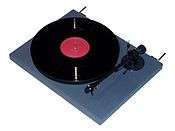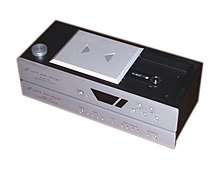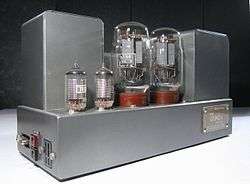Audiophile
An audiophile is a person who is enthusiastic about high-fidelity sound reproduction.[1] An audiophile seeks to reproduce the sound of a live musical performance, typically in a room with good acoustics. It is widely agreed that reaching this goal is very difficult and that even the best-regarded recording and playback systems rarely, if ever, achieve it.[2][3]
Audiophile values may be applied at all stages of music reproduction: the initial audio recording, the production process, and the playback, which is usually in a home setting. In general, the values of an audiophile are seen to be antithetical to the growing popularity of more convenient but lower quality music, especially lossy digital file types like MP3, lower definition streaming services, and inexpensive headphones.[4]
The term high-end audio refers to playback equipment used by audiophiles, which may be bought at specialist shops and websites.[5] High-end components include turntables, digital-to-analog converters, equalization devices, preamplifiers and amplifiers (both solid-state and vacuum tube), horn and electrostatic speakers, power conditioners, subwoofers, headphones, and acoustic room treatment in addition to room correction devices.[6][7]
Audio playback components
An audio system typically consists of one or more source components, one or more amplification components, and (for stereo) two or more loudspeakers.[8]
Signal cables (analog audio, speaker, digital audio etc.) are used to link these components. There are also a variety of accessories, including equipment racks, power conditioners, devices to reduce or control vibration, record cleaners, anti-static devices, phonograph needle cleaners, reverberation reducing devices such as speaker pads and stands, sound absorbent foam, and soundproofing.
The interaction between the loudspeakers and the room (room acoustics) plays an important part in sound quality. Sound vibrations are reflected from walls, floor and ceiling, and are affected by the contents of the room. Room dimensions can create standing waves at particular (usually low) frequencies. There are devices and materials for room treatment that affect sound quality. Soft materials, such as draperies and carpets, can absorb higher frequencies, whereas hard walls and floors can cause excess reverberation.



Sound sources
Audiophiles play music from a wide variety of sources including phonograph records, compact discs (CDs), and digital audio file formats that are uncompressed as well as ones that are compressed using lossless data compression such as FLAC, DSD, Windows Media Audio 9 Lossless and Apple Lossless (ALAC). Since the early 1990s, CDs have become the most common source of high-quality music. Nevertheless, turntables, tonearms, and magnetic cartridges are still used, despite the difficulties of keeping records free from dust and the delicate set-up associated with turntables.
The 44.1 kHz sampling rate of the CD format, in theory, restricts CD information losses to above the theoretical upper-frequency limit of human hearing – 20 kHz, see Nyquist limit. Despite this, newer formats such as FLAC, ALAC, DVD-Audio and Super Audio Compact Disc (SACD), have sampling rates of 88.2 kHz or 96 kHz or even higher such as 192 kHz.
CD audio signals are encoded in 16-bit values. Some higher-definition consumer formats such as HDCD-encoded CDs, DVD-Audio, and SA-CD contain 20-bit, 24-bit and even 32-bit audio streams. With more bits more dynamic range is possible; 20 bit dynamic range is theoretically 120 dB—the limit of most consumer electronic playback equipment.[9]
MP3 encoding, widely used in portable audio devices, is an example of lossy compression.
SACD's and DVD-Audio have up to 5.1 to 6.1 surround sound. Although both high-res optical formats have failed, there has been a resurgence in high-res digital files. SACD can be stored as a DSD file, and DVD-Audio can be stored as a FLAC or ALAC file. FLAC is the most widely used digital format for high-res with up to 8 channels and a maximum depth of 32 bit, and 65,535 Hz sampling rate. Uncompressed formats such as WAV and AIFF files can store audio CDs with no compression.
Amplifiers
A preamplifier selects among several audio inputs, amplifies source-level signals (such as those from a turntable), and allows the listener to adjust the sound with volume and tone controls. Many audiophile-oriented preamplifiers lack tone controls. A power amplifier takes the "line-level" audio signal from the preamplifier and drives the loudspeakers. An integrated amplifier combines the functions of power amplification with input switching and volume and tone control. Both pre/power combinations and integrated amplifiers are widely used by audiophiles.
Audiophile amplifiers are available based on solid-state (semiconductor) technology, vacuum-tube (valve) technology, or hybrid technology—semiconductors and vacuum tubes.
Dedicated amplifiers are also commonly used by audiophiles to drive headphones, especially those with high impedance and/or low sensitivity, or electrostatic headphones.
Loudspeakers
The cabinet of the loudspeaker is known as the enclosure. There are a variety of loudspeaker enclosure designs, including sealed cabinets (acoustic suspension), ported cabinets (bass-reflex), transmission line, infinite baffle, and horn loaded. The enclosure plays a major role in the sound of the loudspeaker.
The drivers that produce the sound are referred to as tweeters, midranges, and woofers. Driver designs include dynamic, electrostatic, plasma, ribbon, planar, ionic, and servo-actuated. Drivers are made from a variety of materials including paper pulp, polypropylene, kevlar, aluminum, magnesium, beryllium, and vapor-deposited diamond.
The direction and intensity of the output of a loudspeaker, called dispersion or polar response, has a large effect on its sound.[10] Various methods are employed to control the dispersion. These methods include monopolar, bipolar, dipolar, 360-degree, horn, waveguide, and line source. These terms refer to the configuration and arrangement of the various drivers in the enclosure.
The positioning of loudspeakers in the room has a strong influence on the sound experience.[11][12] Loudspeaker output is influenced by interaction with room boundaries, particularly bass response, and high frequency transducers are directional, or "beaming".
Accessories
Audiophiles use a wide variety of accessories and fine-tuning techniques, sometimes referred to as "tweaks", to improve the sound of their systems. These include power conditioner filters to "clean" the electricity,[13] equipment racks to isolate components from floor vibrations, specialty power and audio cables, loudspeaker stands (and footers to isolate speakers from stands), and room treatments.
There are several types of room treatment. Sound-absorbing materials may be placed strategically within a listening room to reduce the amplitude of early reflections, and to deal with resonance modes. Other treatments are designed to produce diffusion, reflection of sound in a scattered fashion. Room treatments can be expensive and difficult to optimize.
Headphones
Headphones are regularly used by audiophiles. These products can be remarkably expensive, some over $10,000,[14] but in general are much cheaper than comparable speaker systems. They have the advantage of not requiring room treatment, and being usable without requiring others to listen at the same time. Newer canalphones can be driven by the less powerful outputs found on portable music players.
Design variety
For music storage, digital formats offer an absence of clicks, pops, wow, flutter, acoustic feedback, and rumble, compared to vinyl records. Depending on the format, digital can also have a higher signal-to-noise ratio, a wider dynamic range, less total harmonic distortion, and a flatter and more extended frequency response.[15][16] Despite this, vinyl records remain popular, and discussion about the relative merits of analog and digital sound continues (see Analog sound vs. digital sound). (Note that vinyl records may be mastered differently from their digital versions.)
In the amplification stage, vacuum-tube electronics remain popular, despite most other applications having since abandoned tubes for solid state amplifiers. Also vacuum-tube amplifiers often have higher total harmonic distortion, require rebiasing, are less reliable, generate more heat, are less powerful, and cost more.[17] There is also continuing debate about the proper use of negative feedback in amplifier design.[18][19]
Controversies
There is substantial controversy on the subject of audiophile components; many have asserted that the occasionally high cost produces no measurable improvement in audio reproduction.[20] For example, skeptic James Randi, through his foundation One Million Dollar Paranormal Challenge, has offered a prize of $1 million to anyone who can demonstrate that $7,250 audio cables "are any better than ordinary audio cables".[21] In 2008, audio reviewer Michael Fremer attempted to claim the prize, and said that Randi declined the challenge.[22] Randi said that the cable manufacturer Pear Cables was the one who withdrew.[23]
Criticisms usually focus on claims around so-called "tweaks" and accessories beyond the core source, amplification, and speaker products. Examples of these accessories include speaker cables, component interconnects, stones, cones, CD markers, and power cables or conditioners.[24][25]
There is disagreement on how equipment testing should be conducted and as to its utility. Audiophile publications frequently describe differences in quality which are not detected by standard audio system measurements and double blind testing, claiming that they perceive differences in audio quality which cannot be measured by current instrumentation,[26] and cannot be detected by listeners if listening conditions are controlled,[27] but without providing an explanation for those claims.
References
- "Audiophile". Dictionary.reference.com. 2011. Retrieved 6 December 2011.
- Lichte, Erick (2 July 2012). "Audio Research Reference 150 power amplifier". Stereophile.
- Doris, Frank (1993). "Hi Fi in the Arena: The Concert Sound of the Grateful Dead". The Absolute Sound.
- Kurutz, Steven (24 July 2013). "The new audio geeks". The New York Times.
- Perlman, M. (2004). "Golden ears and meter readers: The contest for epistemic authority in Audiophilia". Social Studies of Science. 34 (5): 783. doi:10.1177/0306312704047613.
- van der Veen, M. (2005). "Universal system and output transformer for valve amplifiers" (PDF). 118th AES Convention, Barcelona, Spain.
- O'Connell, Joseph (January 1992). "The Fine-Tuning of a Golden Ear: High-End Audio and the Evolutionary Model of Technology". Technology and Culture. Society for the History of Technology. 33 (1): 1–37. doi:10.2307/3105807. ISSN 0040-165X. JSTOR 3105807.
- "Sound Systems". Media college.com. Retrieved 3 July 2012.
- Huber, David Miles; Robert E. Runstein (2005). Modern Recording Techniques, Sixth Edition. Focal Press. p. 130. ISBN 0-240-80625-5.
- "The 'Best' Loudspeaker: Revisiting Dispersion Issues". EnjoyTheMusic.com. May 1999. Retrieved 3 July 2012.
- Hoffman, David (8 October 2000). "Loudspeaker Room Placement -- Part 1". onhifi.com. Archived from the original on 21 December 2016. Retrieved 3 July 2012.
- Atkinson, John (3 October 2008). "Getting the Best from Your Loudspeakers". Stereophile.
- "Power Conditioner Reviews". Audioholics.
- Woollard, Deidre (14 December 2005). "Sennheiser HE 90 Headphones". Luxist. Archived from the original on 28 September 2007. Retrieved 30 June 2007.
- Ian G. Masters (1 January 2003). "The Decline of Vinyl and Its Timely Death". mastersonaudio.com. Archived from the original on 6 September 2005.
- Ian G. Masters (15 April 2005). "Vinyl Hooey". mastersonaudio.com. Archived from the original on 20 March 2006.
- Ian G. Masters (1 September 2002). "The Ongoing Debate about Amplifier "Sound"". mastersonaudio.com. Archived from the original on 30 August 2007.
- Martin Colloms (January 1998). "A Future Without Feedback?" (PDF). Stereophile. Archived from the original (PDF) on 19 June 2013. Retrieved 9 May 2007.
- Bruno Putzeys (February 2011). "The 'F' word, or why there is no such thing as too much feedback" (PDF). Linear Audio. Archived from the original (PDF) on 11 July 2013. Retrieved 19 March 2013.
- "Lost in music: the world of obsessive audiophilia". The Guardian.
- "James Randi Offers $1 Million If Audiophiles Can Prove $7250 Speaker Cables Are Better". Gizmodo. 2005. Archived from the original on 2 February 2009. Retrieved 6 January 2009.
- "The Swift Boating of Audiophiles". Stereophile. 2008. Retrieved 4 January 2011.
- "Blake Withdraws from PEAR Cable Challenge". JREF. 2007. Retrieved 8 January 2011.
- Kinch, Bruce (2000). "Cheap Tweaks That Sound Like a Million Bucks!!!". Enjoy The Music. Archived from the original on 30 July 2012. Retrieved 7 November 2007.
- Russell, Roger (1999–2007). "Speaker Wire - A History". Roger Russell. Archived from the original on 5 November 2007. Retrieved 7 November 2007.
- "God is in the Nuances". Retrieved 25 March 2007.
- "The Highs and Lows of Double Blind Testing". Retrieved 23 May 2013.
External links
- Audiophilia: The Online Journal for the Serious Audiophile
- Why We Need Audiophiles (Gizmodo)
- High end Audio and Audiophile Pages
- Enjoy the Music.com: Equipment reviews, industry news, shows reports, etc.
- Portuguese High end Audio benchmark reviews and reports website from José Victor Henriques.
- Audio Societies